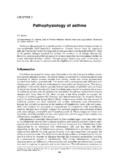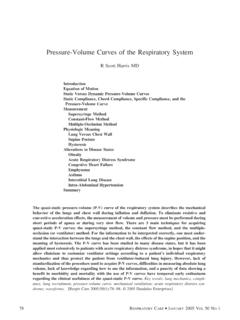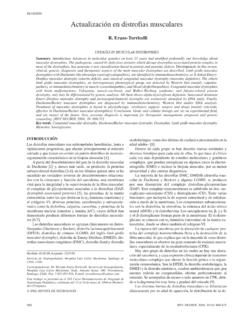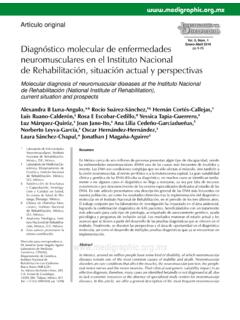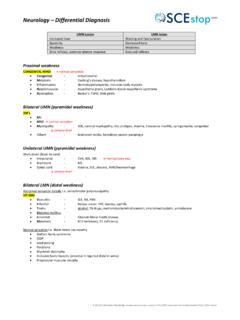Transcription of Respiratory Complications of the Muscular …
1 231 Pulmonary Complications of Neuromuscular Diseases; Editor in Chief, Joseph P. Lynch, III, ; Guest Editor, Nicholas S. Hill, in Respiratory and Critical Care Medicine, volume 23, number 3, 2002. Address for correspondence and reprint requests: Anita Simonds, , Royal Brompton Hospital, Sydney Street, London, SW3 6NP, England. E-mail: Brompton &Harefield NHS Trust, London, England. Copyright 2002 by Thieme Medical Publishers, Inc., 333 Seventh Avenue, New York, NY 10001,USA. Tel: +1(212) 584-4662. 1069-3424,p;2002,23,03,231,238,ftx,en; Complications of the Muscular DystrophiesAnita K. Simonds, Complications including chest infections, atelectasis, pulmonary hy-poplasia and ventilatory failure are the leading cause of death in the Muscular dystrophiesand atrophies. Ventilatory insufficiency is virtually inevitable in Duchenne Muscular dys-trophy and type 1 spinal Muscular atrophy (SMA), but more variable in limb-girdle, con-genital, and facioscapulohumeral Muscular dystrophy.
2 A cardiomyopathy may complicateDuchenne, Becker, and Emery-Dreifuss Muscular dystrophies . Most patients respondwell to ventilatory support with reduced pulmonary morbidity and extended monitoring and anticipation of Complications are important so that ventilatoryassistance can be started in a timely :Duchenne Muscular dystrophy, spinal Muscular atrophy, noninvasiveventilationObjectives:Upon completion of this article, readers should be able to: (1) describe the pathophysiology of Respiratory decompen-sation in the Muscular dystrophies ; (2) identify Muscular dystrophy patients at high risk of Respiratory Complications ; and (3) under-stand the role of ventilatory support in the management of Respiratory problems in Muscular :The University of Michigan is accredited by the Accreditation Council for Continuing Medical Education to sponsorcontinuing medical education for :The University of Michigan designates this educational activity for a maximum of hour in category one credits towardthe AMA Physicians Recognition Muscular atrophy (SMA).
3 This article will coverthe spectrum of Muscular dystrophies and atrophies, theprobability of Respiratory decompensation, the evolu-tion of the pathophysiology, and the potential for rever-sal of Respiratory term Muscular dystrophy is used classically todefine a group of congenital conditions with progressivedegeneration of skeletal muscle and no associated ab-normality in the central or peripheral nervous , this terminology is flawed. For example, someof the milder forms of facioscapulohumeral musculardystrophy show little progression, other variants mayRespiratory Complications are by far the com-monest cause of morbidity and mortality in the muscu-lar dystrophies . In Duchenne Muscular dystrophy(DMD), Respiratory problems are the cause of death inover 70% of patients, and virtually all DMD patientswill develop Respiratory insufficiency if they survivelong enough.
4 In other Muscular dystrophies , the extentof Respiratory compromise depends on the degree of in-spiratory and expiratory muscle involvement, the pres-ence of thoracic scoliosis or a rigid spine, and bulbarweakness. Congenital pulmonary hypoplasia may occurin some patients with congenital Muscular dystrophy or232 SEMINARS IN Respiratory AND CRITICAL CARE MEDICINE/VOLUME 23, NUMBER 3 2002not show a typically dystrophic pattern, and in somecases of congenital Muscular dystrophy, there are associ-ated central nervous system features such as white mat-ter changes in the brain. Advances in the understandingof the molecular biology of Muscular dystrophies mayeventually lead to a more rational classification, but inthe meantime, categorization will continue to be basedon clinical phenotype, mode of inheritance, and OF MUSCULARDYSTROPHIESThe inheritance patterns and Respiratory complicationsassociated with most forms of Muscular dystrophy areshown in Table 1.
5 In the last decade, tremendous prog-ress has been made in the identification of the genes re-sponsible for these disorders. Indeed, the discovery ofthe gene responsible for DMD and identification of thegene product dystrophin have been key developments inour understanding of a whole series of neuromuscularconditions. Normally in DMD, dystrophin is absenton muscle biopsy, whereas variable amounts are presentin Becker Muscular dystrophy. The dystrophins are afamily of proteins that form complexes linking the ex-tracellular matrix and intracellular actin across the cellmembrane. Subtle changes in the dystrophin-relatedcomplex have been implicated in the milder proximalmyopathies and other non-X-linked Muscular dystro-phies. Abnormalities of sarcoglycan may be seen inlimb-girdle Muscular dystrophy (LGMD), and merosinimmunohistochemistry can help elucidate the merosinpositive and merosin negative congenital Muscular dys-trophies.
6 As a result of these findings, we are now in abetter position to accurately identify the Muscular dys-trophies and understand their natural histories. This re-search also offers the possibility of effective gene ther-apy in the PATHOPHYSIOLOGYIn many cases, a well-recognized spiral of respiratorydecline starting with a loss of lung volumes occurs, fol-lowed by progressive weakness in inspiratory and expi-ratory muscles, chest infections, sleep-disordered breath-ing, and, ultimately, daytime ventilatory failure (Fig. 1).Apneas and hypopneas are seen during rapid eye move-ment (REM) sleep before they appear during non-REM sleep because of the physiological changes thataccompany REM sleep, including intercostal inhibitionand loss of accessory muscle tone, reduction in ventila-tory drive, and diminution in the arousal response (seePiper article).
7 The rate of evolution of Respiratory failurevaries from disease to Muscular DYSTROPHYDMD is the most common Muscular dystrophy inher-ited in childhood with an incidence of 1 in 3500 livemale births. Features of motor delay prompt the diag-Table 1 Inheritance and Pulmonary Complications of the Congenital Muscular dystrophies andSpinal Muscular AtrophyMode ofGene ProductRespiratoryDiseaseInheritance(whe re known)ComplicationsMuscularDuchenneX-LRV entilatory failuredystrophiesDystrophinScoliosisAte lectasisCardiomyopathyBeckerX-LRDystroph inVentilatory failurerelatively uncommonCardiomyopathyLimb-girdleARAdhal inVariableADventilatory failureCongenital:ScoliosisMerosin +veARalpha2 lamininVentilatory failureMerosin veARFacioscapulohumeralADVentilatory failureUncommonEmery-X-LREmerinVentilato ry failureDreifussArrhythmiasSpinal muscularSpinalAR, ADType 1 type 3atrophy (SMA)muscularEarly to late onsetatrophyvent failureAD, autosomal dominant; AR, autosomal recessive.
8 X-LR, X-linked Complications OF THE Muscular dystrophies /SIMONDS233 Figure 1 Development of arterial blood gas abnormalities dur-ing sleep disordered breathing in the Muscular in approximately 20% of cases by the age of 2years and 75% by the age of 4 years. In a series reportedby Rideau et al,150% of DMD patients developed asignificant thoracic scoliosis at the time of the pubertalgrowth spurt, and the average age for losing ambulationwas 10 years. Dubowitz2has used loss of ambulation todistinguish the Duchenne and Becker phenotypes. Lossof ambulation before 13 years defines the Duchennegroup and after 16 years typifies the Becker group. Inthose who begin use of a wheelchair between the agesof 13 and 16 years, the term intermediate Muscular dys-trophyis sometimes used. Limb muscle weakness inDMD is initially proximal, but distal involvement oc-curs with longitudinal study of lung function has shownthat forced vital capacity (FVC) as a percent of pre-dicted begins to fall at around the age of 10 years et al3found an average yearly decline inFVC of 5%.
9 When the vital capacity falls to below 1liter, hypercapnia is likely, although there is considerablevariation between individuals. Inspiratory and expira-tory muscle weakness generally occur in tandem inDMD patients, thereby simultaneously reducing venti-latory efficiency and cough breathing usually arises duringthe early teenage years. Khan et al4studied 21 asympto-matic nonambulant patients with DMD aged 13 to 23years (mean vital capacity 35% predicted). Two-thirdsof the patients had hypoxemic dips to < 90% overnight,and 60% of these events were obstructive apneas andhypopneas. Most desaturations occurred during REMsleep. There was a strong correlation between the fre-quency and severity of hypoxemic dips and age (p< ), and years of wheelchair use (p= ).
10 All boysover the age of 14 had hypoxemic events; only three ofthose under the age of 13 experienced such of the patients with nocturnal hypoxemiahad serial follow-up. Over time, there was worseninghypoxemia, but a fall in the proportion of obstructiveevents, such that a pure hypoventilation picture pre-dominated. Phillips et al5followed 19 DMD patientsfor 10 years after an initial sleep study and showedworsening REM-related desaturation until death or theintroduction of nocturnal ventilatory support. Meansurvival was unrelated to Respiratory muscle strength asmeasured by mouth pressures, or body mass , mortality was correlated with daytime pCO2(r= ,p< ), minimum nocturnal SaO2 (r= , p < ), and vital capacity (r= ,p< ).The best single predictor of mortality was a vital capac-ity of less than 1 an older group of DMD patients (mean age 18 2 years, vital capacity 27% predicted)), Barbe et al6found that 70% had symptoms of daytime somnolence,headaches, nightmares, or difficulty sleeping.
